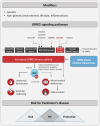Molecular mechanisms defining penetrance of LRRK2-associated Parkinson's disease
- PMID: 38835904
- PMCID: PMC11006382
- DOI: 10.1515/medgen-2022-2127
Molecular mechanisms defining penetrance of LRRK2-associated Parkinson's disease
Abstract
Mutations in Leucine-rich repeat kinase 2 (LRRK2) are the most frequent cause of dominantly inherited Parkinson's disease (PD). LRRK2 mutations, among which p.G2019S is the most frequent, are inherited with reduced penetrance. Interestingly, the disease risk associated with LRRK2 G2019S can vary dramatically depending on the ethnic background of the carrier. While this would suggest a genetic component in the definition of LRRK2-PD penetrance, only few variants have been shown to modify the age at onset of patients harbouring LRRK2 mutations, and the exact cellular pathways controlling the transition from a healthy to a diseased state currently remain elusive. In light of this knowledge gap, recent studies also explored environmental and lifestyle factors as potential modifiers of LRRK2-PD. In this article, we (i) describe the clinical characteristics of LRRK2 mutation carriers, (ii) review known genes linked to LRRK2-PD onset and (iii) summarize the cellular functions of LRRK2 with particular emphasis on potential penetrance-related molecular mechanisms. This section covers LRRK2's involvement in Rab GTPase and immune signalling as well as in the regulation of mitochondrial homeostasis and dynamics. Additionally, we explored the literature with regard to (iv) lifestyle and (v) environmental factors that may influence the penetrance of LRRK2 mutations, with a view towards further exposomics studies. Finally, based on this comprehensive overview, we propose potential future in vivo, in vitro and in silico studies that could provide a better understanding of the processes triggering PD in individuals with LRRK2 mutations.
Keywords: LRRK2; Parkinson’s disease; Rab signalling; environment; genetic modifiers; mitochondria; penetrance; toxin exposure.
© 2022 the author(s), published by De Gruyter.
Conflict of interest statement
Competing interests: Authors state no conflict of interest.
Figures


Similar articles
-
Exploring environmental modifiers of LRRK2-associated Parkinson's disease penetrance: An exposomics and metagenomics pilot study on household dust.Environ Int. 2024 Dec;194:109151. doi: 10.1016/j.envint.2024.109151. Epub 2024 Nov 16. Environ Int. 2024. PMID: 39571299
-
The Gly2019Ser mutation in LRRK2 is not fully penetrant in familial Parkinson's disease: the GenePD study.BMC Med. 2008 Nov 5;6:32. doi: 10.1186/1741-7015-6-32. BMC Med. 2008. PMID: 18986508 Free PMC article.
-
Genetic analysis and natural history of Parkinson's disease due to the LRRK2 G2019S variant.Brain. 2024 Jun 3;147(6):1996-2008. doi: 10.1093/brain/awae073. Brain. 2024. PMID: 38804604 Free PMC article.
-
The Cell Biology of LRRK2 in Parkinson's Disease.Mol Cell Biol. 2021 Apr 22;41(5):e00660-20. doi: 10.1128/MCB.00660-20. Print 2021 Apr 22. Mol Cell Biol. 2021. PMID: 33526455 Free PMC article. Review.
-
LRRK2 GTPase dysfunction in the pathogenesis of Parkinson's disease.Biochem Soc Trans. 2012 Oct;40(5):1074-9. doi: 10.1042/BST20120093. Biochem Soc Trans. 2012. PMID: 22988868 Free PMC article. Review.
Cited by
-
Perspective on the current state of the LRRK2 field.NPJ Parkinsons Dis. 2023 Jul 1;9(1):104. doi: 10.1038/s41531-023-00544-7. NPJ Parkinsons Dis. 2023. PMID: 37393318 Free PMC article. Review.
-
Microglial dynamics and neuroinflammation in prodromal and early Parkinson's disease.J Neuroinflammation. 2025 May 21;22(1):136. doi: 10.1186/s12974-025-03462-y. J Neuroinflammation. 2025. PMID: 40399949 Free PMC article. Review.
-
Analysis of rare Parkinson's disease variants in millions of people.NPJ Parkinsons Dis. 2024 Jan 8;10(1):11. doi: 10.1038/s41531-023-00608-8. NPJ Parkinsons Dis. 2024. PMID: 38191580 Free PMC article.
-
The age at onset of LRRK2 p.Gly2019Ser Parkinson's disease across ancestries and countries of origin.medRxiv [Preprint]. 2025 Jun 9:2025.06.04.25327685. doi: 10.1101/2025.06.04.25327685. medRxiv. 2025. PMID: 40585066 Free PMC article. Preprint.
-
The p.Gly2019Ser is a common LRRK2 pathogenic variant among Egyptians with familial and sporadic Parkinson's disease.NPJ Parkinsons Dis. 2024 Nov 6;10(1):215. doi: 10.1038/s41531-024-00826-8. NPJ Parkinsons Dis. 2024. PMID: 39505921 Free PMC article.
References
-
- Paisan-Ruiz C. et al. Cloning of the gene containing mutations that cause PARK8-linked Parkinson’s disease. Neuron. 2004;44(4):595–600. - PubMed
-
- Chen W. et al. Gender differences in prevalence of LRRK2-associated Parkinson disease: A meta-analysis of observational studies. Neurosci Lett. 2020;715:134609. - PubMed
-
- Trinh J. et al. Comparative study of Parkinson’s disease and leucine-rich repeat kinase 2 p.G2019S parkinsonism. Neurobiol Aging. 2014;35(5):1125–31. - PubMed
-
- Aasly JO. et al. Clinical features of LRRK2-associated Parkinson’s disease in central Norway. Ann Neurol. 2005;57(5):762–5. - PubMed
Grants and funding
LinkOut - more resources
Full Text Sources
Miscellaneous
